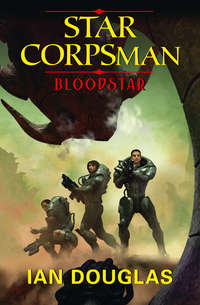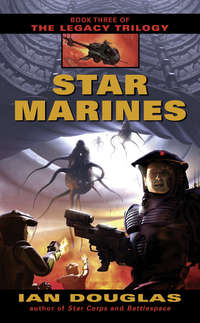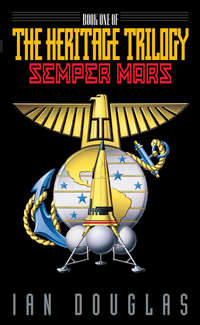
Полная версия
Abyss Deep
“That’s because your pressure receptors are still firing. Don’t worry. You’re going to be fine.”
I hoped. His extremities were already starting to cool, which meant he was already shocky. I ordered his suit to clamp down on his upper arm to reduce the brachial artery flow, then raise its internal temp slightly and relax the external pressure on the arteries leading to his head to interrupt the shock response.
I had to make a quick decision, though. The armor clamp would slow the bleeding, but wouldn’t stop it by itself. I could cram a packet of skinseal into the injury, and let that seal off the wound … or I could order his suit to slice off what was left of his arm well above the bleeding stump. The guillotine at his elbow, obviously, was smashed; the next working blade was eight centimeters up, midway up his humerus. The nanonarcs would block the pain, or most of it, but he would still feel it, and that would increase the risk of shock.
Shock or not, I elected to cut. Skinseal is great stuff, but it’s better for minor bleeding. And if the mining station’s outer hull didn’t seal off the leaks, Morrisey would have other problems in a moment if he started losing air.
I again checked his nananodyne levels, then thoughtclicked through the link to trigger the suit’s chopper. Another chunk of his arm came off, a squat cylinder encased in black armor, but the bleeding stopped at once.
“God,” he said. “I’m gonna be sick… .”
“No,” I told him. “You’re not.”
Vomiting inside a space suit is very serious business, and can lead to drowning. Morrisey’s armor was already firing antiemetic ’bots into his carotid artery, but it wasn’t enough.
The vomiting reflex is triggered in the area postrema, a tiny nub on the floor of the brain’s fluid-filled fourth ventricle snugged up against the cerebellum. There are a number of different chemical pathways leading to emeses triggers, but most involve a neuropeptide called substance P, or SP, which is found in both the brain and the spinal cord and which is associated with inflammation, pain, and shock.
I pulled my N-prog from my M-7 medical kit and thought a quick series of commands into it. The device, in turn, reprogrammed some of the nananodyne bots now circulating through Morrisey’s brain, ordering them to block out the SP … and also to shut down the cholinergic receptor input from his inner ears, since his vestibular system—reacting to zero-G—was also screaming at him. The reprogrammed ’bots would add to the suit’s antiemetic response, helping to stifle Morrisey’s nausea before he vomited inside his helmet.
“Yeah,” Morrisey said. “Yeah … that’s … that’s better, Doc. Thanks.”
I gave his readouts a final check. His BP was stabilizing at 125 over 70, and his respiration was a bit slower now. “You’ll be fine,” I told him. “Some time in sick bay, and we’ll grow you a new arm, better than the old.”
He nodded inside his helmet. “I know.”
I sent him back to the doughnut to await a medevac. Now that we had our foothold on board Zeta, more Marines were on the way in, along with support vessels and transports to haul away the wounded. I made my way toward the second breach in the bulkhead, slipping through and into the compartment on the other side. The fighting appeared to be over—here, at least. There was a seething mob of people in brown utilities, more spacesuited bodies, Marines, and a lot more drifting globules of blood, a tangle too confused for me to count. Marines were moving among the rescued hostages, cuffing their hands with zipstrips. Until we were absolutely sure of who was a tango and who was a hostage, we handled them all as potential terrorists. There was a bank of link-in controls along one bulkhead. I saw one deeply padded seat with a dead tango strapped into it, his hands still on the palmpads on the chair’s arms. He’d probably been the terrorist commander, running the station’s defenses by jacking in at this secondary control center, but the ugly crater in his spacesuit’s chest showed that a Marine had taken him out with a laser rifle.
“Corpsman, front!”
I homed on this new call, pushing my way through the milling civilians and Marines. Gunny Hancock was waving to me from an open hatch in the bulkhead beyond. “In here, Doc! On the double!”
Drifting through the opening, I entered a small and bare compartment—probably a storage locker. There were two M’nangat drifting inside, and one of them looked like it was hurt. Another dead tango floated near the overhead, a MAW pistol still clutched his hand.
I drifted over to the alien. “What happened?” I asked.
“That guy shot him,” Hancock said, “just as we came through the door. Is it bad?”
“It’s not good.”
The M’nangat are surprisingly like us biologically—carbon-based oxygen breathers, with metal-chelated tetrapyroles pumped through an enclosed circulatory system by a pair of two-chambered hearts working in synch. They even use DNA for genetic coding rather than one of several other xenobiological possibilities, but that’s where the similarities stop. The being was a couple of meters long, resembling a pale, blue-green pillar of thick, tightly twisted tentacles like a tree’s trunk, which then spread out from the creature’s base like the roots of a tree. At the top end was what looked like a half-meter cluster of grapes—though each grape was the size of an orange—translucent, and shot through with flecks of red and gold. The wounded one had a savage puncture in one side of its leathery trunk, and blue-green liquid was jetting in spurts from the wound with enough force to paint one bulkhead and drive the being into the other like a small rocket. Slits beneath the grape cluster representing mouths and breathing apertures gaped and pulsed, and the being uttered a startlingly human-sounding groan.
“You’ll be okay, fella,” I said. The reassurance was automatic; I didn’t expect the creature to answer. But a link switched on within my in-head, and the words “Thank you” wrote themselves out on an inner window.
I’d not realized that the M’nangat shared something else with us besides our body chemistries, that they had CNS prostheses that, among other things, could connect with an AI residing within their internal hardware and communicate with other software in the area … such as a translator program.
And as soon as I thought about that, something clicked into place … something I’d just seen and not thought about, but which represented a terrible danger to the station and to us.
“Gunny!” I yelled, turning. “That dead tango in the seat out there …”
“What about him, Doc?”
“If he has an AI—”
I saw Hancock’s eyes widen behind his helmet visor. It had clicked for him too. He turned to duck out of the small compartment, but in that same instant I felt a solid jolt, and the sensation of weight tugged at me with a terrifying insistence. It wasn’t much—maybe a tenth of a gravity, but it was terrifying in its implications.
The massive meta-fueled thrusters mounted to the surface of Atun 3840 had just fired. The one-kilometer asteroid and its attached mining station were decelerating … which meant we were now beginning to fall out of orbit and toward the Earth’s surface.
And if we hit we were going to leave one hell of a big crater.
Chapter Two
We were falling out of the sky.
I knew immediately what had happened … and kicked myself for not picking up on it as soon as I’d seen that dead tango in the control seat. The guy might have been a neo-Ludd … but if he was running the control software for Capricorn Zeta—that’s the only reason he would have been strapped into that chair with his hands on the palm interfaces—then he must have had a resident AI inside his in-head hardware, his cerebral implant. I have one; all Marines do as well, and most civilians have them too. It’s how we can interface with all of the thousands of computers and control systems around us every day, from operating devices like my N-prog to pulling down in-head data feeds and scans and communication to telling the deck to grow a chair.
And a person doesn’t have to be alive for the AI to keep working.
Whoever had helped the neo-Ludds take over Capricorn Zeta had had some high-powered technology behind them, and that would include AIs carefully programmed to help carry out their mission. That meant there would have been some sort of backup electronic deadman’s switch; the man controlling the station dies, and his software tells the station to destroy itself … taking out a big part of the planet as it does so.
I heard Thomason’s shouts outside. “Get his hands off of there! Get him out of that fucking seat!” But moment followed moment and the deceleration continued. The neo-Ludd software must have had run-if-interrupted code sequences. Someone would have to regain control of the system to stop those rockets.
That wasn’t my immediate problem, however. The Marines had people who could regain control of the falling asteroid. I had a patient to worry about. If we re-entered Earth’s atmosphere he would die—as would I—but he would die anyway even if we regained a stable orbit and I didn’t patch him up.
There are certain priorities in treating a wounded patient no matter what his, her, or its species might be. The M’nangat was losing blood fast, and that was my immediate priority. M’nangat blood is cupriglobin, copper-based, rather than iron-based as with human hemoglobin. That’s why the blue-green color of the blood. But the different blood chemistry wouldn’t affect skinseal. These guys had a similar body temperature, and their skin, though thicker than in humans, was made up of the same sorts of carbon-based keratinocytes, keratin proteins, and lipids.
I pulled a packet of skinseal from my M-7 kit, thumbed it open, and pressed the whole pack, powder-side-down, over the wound. Skinseal includes both absorbents and binding nanoagents that would work on a variety of more or less similar body building blocks.
As it worked, I pulled down the species EG data from the Orbital Net.
Encyclopedia Galactica/Xenospecies Profile
Entry: Sentient Galactic Species 14566
“M’nangat”
M’nangat, “M’naggies,” “Broccolis,” “Brocs,” “Stalks”
Civilization type: 1.042 G
TL 19: FTL, Genetic Prostheses, Cerebral Prostheses
Societal code: AQCB
Dominant: loose associative/scavenger/defensive/sexual
Cultural library: 4.11 x 1016 bits
Data Storage/Transmission DS/T: 3.07 x 1011s
Biological code: 156.872.119
Genome: 3.8 x 109 bits; Coding/non-coding: 0.028.
Biology: C, N, O, S, H2O, PO4
DNA
Cupric metal-chelated tetrapyroles in aqueous circulatory fluid.
Mobile heterotrophs, omnivores, O2 respiration.
Upright tentacular locomotion.
Mildly gregarious, Polyspecific [1 genera, 12 species]; trisexual.
Communication: modulated sound at 150 to 300 Hz.
Neural connection equivalence NCE = 1.1 x 1014
T = ~260o to 300o K; M = 0.9 x 105 g; L: ~2.5 x 109s
Vision: ~200 nanometers to 720 nanometers; Hearing: 12 Hz to 18,000 Hz
Member: Galactic Polylogue
Receipt galactic nested code: 3.86 x 1010 s ago
Locally initiated contact 0.11 x 109 s ago
Star G1V; Planet: Fourth; “M’gat”
a = 1.669 x 1011m; M = 8.5 x 1027g; R = 7.2 x 106m; p = 3.6 x 107s
Pd = 2.3 x 105s, G = 10.9 m/s2 Atm: O2 20.1, N2 79.6, CO2 0.3;
Patm 0.97 x 105 Pa
Librarian’s note: First direct human contact occurred in 2119 C.E., the very first extraterrestrial space-faring civilization encountered by Humankind. Threat level—8.
I let the numbers cascade through my brain, watching for anything that was so far out of the ordinary that it would put up a red flag. Ordinary when discussing alien biochemistry takes in a huge chunk of territory, of course, but there were some basic rules to play by if the patient was a carbon-based oxygen breather. Hell, compared to some of the critters we’ve encountered out there, methane-breathers and gas giant floaters and fluoro-silicate crystal autotrophs, these guys were practically next of kin.
We’d known the Brocs for over a century, now … since just after the discovery of the local Encylopedia Galactica Node at Sirius. They were our first ET encounter, face-to … whatever it is they have in place of a face. Once we established contact with them, they helped us figure out how to extract the oceans upon oceans of data in the EG, which helped us begin to make some small bit of sense out of the bewildering forest of intelligent life we were encountering as we moved out into the Galaxy. In fact, we were reading parts of the EG only twelve or thirteen years after we logged in; that we were doing so in only thirteen years was due almost entirely to Broc help. They’ve taught us five, so far, of the major Galactic linguae francae, as well as giving us the inside scoop on the slow-motion collapse of the R’agch’lgh Collective in toward the Core. In many ways, they’ve been Humankind’s friendly native guides in our first tentative explorations into the Galaxy jungle at large.
A few have been allowed to come to the Sol System as consultants—so long as they didn’t have astrogation devices that might give away Earth’s most closely guarded secret … exactly where Sol was among the four hundred billion stars of our Galaxy. It pays to be damned cautious in a star wilderness filled with roving predarians and the wreckage of a collapsing galactic empire. These two, according to our pre-mission briefing, had been at Capricorn Zeta to advise us on in-orbit mining techniques.
Unfortunately, they’d been at the wrong place at the wrong time when a Chinese tug declared an emergency and docked alongside. Twenty armed tangos had been hiding on board. As soon as the tug docked, they’d come swarming out of the tug’s cargo compartment and into the mining station.
PLEASE HELP HERM. The words printed themselves out in my in-head as the second, uninjured, M’nangat leaned closer.
Herm. The M’nangat had three sexes, I saw—male, female, and a third that received the fertilized embryo from the female and carried it to term. The wounded one, apparently, was one of those.
They were called life carriers.
I hesitated. I’d already done everything I could for the wounded Broccoli … everything I could, that is, without firing nano into its circulatory system to give me a look from the inside. Putting anything foreign into an alien body was risky, especially if you didn’t know about possible antibody or immune-system responses. The nanobots I carried in my M-7 kit were designed to neatly bypass the human immune response … but how would that play out inside an alien circulatory system?
I pulled out a biochem analyzer and pressed its business end against my patient’s tough, ropy hide. After a moment, I shifted the analyzer to a splatter of blue-green blood near the wound. The readouts downloaded straight into my in-head, giving me a more detailed understanding of the being’s biochemistry than was available on the Net. In particular, I had my AI leapfrog through the incoming data to pinpoint those biochemistries associated with the alien’s immune response.
The immune system for any species is an enormous set of chemistries—varied, complex, and efficient. Even bacteria have their own simple immune system—secreted enzymes that protect the cell against bacteriophage infections. Life forms as complicated as humans have many, many layers of physical and biochemical defenses … and quite a few of those are changing all the time to react to specific threats. I couldn’t expect the M’nangat to be any different.
Our databases on M’nangat physiology weren’t extensive—at least not the ones available to me over the Fleet channels—but I could have my AI run a series of simulations: what would happen if I shot my green patient full of nanobots? The answer came back in a few seconds. There was a solid 86 percent chance that my nano would not trigger an immune response.
Nanobots are designed and programmed with immune responses in mind, of course. They’re coated with buckyweave carbon shells with the active molecular machinery hidden away inside a non-reactive sheath. Still, there was always a small chance—in this case 14 percent—that my nanobots might hit a biochemical trigger and sensitize the organism, telling it in effect that invaders were entering the body and it was time to call out the troops. Those percentages applied to the entire dose of ’bots, of course, and not to each nanobot individually. Otherwise, with a few hundred million foreign particles entering the alien system, sensitization would have been guaranteed.
I looked again at the wound, and decided I would have to accept those odds. The Broc had an entry wound but no exit cavity. The projectile must still be inside.
I felt a shudder through the deck, and then zero-gravity resumed. The meta rockets had switched off. Had the Marines gotten to the controls in time? Or had we just deorbited?
I couldn’t tell, and I was too busy at the moment to link in and query the network. If we hit atmosphere, my work on the alien would be wasted, but if we didn’t burn up on re-entry or slam into the Earth I preferred to have a live patient to a dead one. I kept working.
I used the injector from my M-7 kit to fire a full dose of nanobots into the alien’s hide. As I waited for them to be assimilated, I wondered why we used terms like “Broccoli” or “Stalk” with aliens like the M’nangat. I understood why Marines dehumanized their enemies—especially the human ones—but the M’nangat, as far as we could tell, had been benevolent and helpful galactic neighbors.
The answer, I suppose, was psychological. Friendly the M’nangat may be, but they were still alien, meaning we could never really get inside their heads—or what passes for heads—and understand them nearly as well as, say, a human living in San Antonio can understand a human living in Kyoto. They had their own agenda—all intelligent beings do—and we had no idea what that agenda might be and probably never would. That’s why we were careful not to let them learn where Sol was, why trading and diplomatic exchanges took place at neutral meeting spots like Sirius, just in case.
And that was fair enough, since we had no idea where they hailed from either, other than that their homeworld was the fourth planet of a star only slightly brighter than Sol. In a galaxy of four hundred billion stars, you can’t tell much from that.
But maybe we called the weirdly stalked and tentacled beings Broccoli or Brocs or Stalks to make them seem a little more … comprehensible. Familiar. I glanced up at the sensory cluster, that cluster of orange-sized luminous eyes at one end of the body. Those quivering jelly-globe eyes had no pupils, so I couldn’t tell if it was looking at me, but then, that sphere of light-gathering organs was designed to look in every direction at once.
What kind of brain can see through 360 degrees and straight up at all times? I wondered. What did that suggest about M’nangat psychology?
D’DNAH CARRIES MY BUDS, the uninjured M’nangat said, the translated words typing themselves across my in-head screen. PLEASE …
“I’ll do what I can,” I replied aloud, letting my AI handle the translation and transmission. “I’m just checking to see if your partner is okay on the inside.”
The being floating next to me and my patient was showing no emotion that I could recognize, but the words on my in-head sounded like human pain. Buds … that would be a clutch of young. According to the downloading xeno data, fertilized eggs from the female took root inside the life carrier and grew as buds that eventually tuned into young and chewed their way to freedom.
I tried not to think about that part. M’nangat reproduction was messy, violent, and painful … and the carrier usually didn’t survive. And how did that color their psychology?
The nanobots were clustering now around the wounded being’s internal organs. I used my N-prog to program them to transmit an overlay.
An overlay is a translucent image of a being’s internal structure projected over the image from my unaugmented eyes. I could see the Broc in front of me, but could also see its internal structure in remarkable depth and detail, picked out by hundreds of millions of cell-sized nanobots adhering to every internal surface and transmitting their relative positions to my N-prog. The Broc’s body appeared to fade away, and I could see the muscular system and, just underneath, the crisscrossing weave of cartilage running from tentacles to eyes. They didn’t have true internal skeletons, but the muscles of the body were attached to flexible, cartilaginous scaffolding that doubled as protection for the inner organs. By concentrating, I could let my viewpoint sink deeper. I linked in to the medical data feed from the Net; my AI identified various organs and threw names in so I could tell what I was looking at.
Right away, I could see that my patient was in serious trouble. A ragged cavity extended from the wound into the central core of its body, and a pale, diffuse cloud showed massive internal bleeding. The cartilage had been torn open and several organs damaged, but what really worried me was the bullet.
My nanobots had carefully picked it out: a glittering metal slug now resting immediately above the pulsing two-chambered muscle that was the M’nangat’s upper heart, tucked in beside the artery that corresponded to the aorta in humans. My AI identified the thing from the ’bots’ transmissions. It was an M550ND mag-accelerated nano-D round, and for some reason the thing had not gone off.
And that made it extremely dangerous.
I drew a deep breath, thinking fast. Nanodisassembler rounds are designed to explode on impact, flooding the target with nanobots programmed to dissolve molecular bonds—in essence reducing it to its component atoms. If the nano in that bullet was omnivorous, programmed to dissolve all bonds, it would have been an insanely dangerous round to use inside a space station. More likely, the nano had been programmed to focus on carbon bonds only: deadly for organic chemistries and most plastics, but inert if they slammed into a metal bulkhead.
Which kind were these? I wanted to believe that the tangos hadn’t been that crazy … crazy enough to fire omnivorous nano-D rounds inside Zeta Capricorn’s hull … but their record so far didn’t exactly inspire confidence in their rationality. They’d threatened to drop a one-kilometer rock onto Earth from orbit, for God’s sake … and when the Marines came on board, they’d set the deadly machinery in motion. When Atun 3840 touched down, the impact quite possibly could kill billions.
WHAT DO YOU SEE? the uninjured M’nangat asked. He … no, she—my data link provided that correction—wasn’t linked into my download feed, but could tell that I was peering closely at something inside her friend. She sounded as worried as any human might be.
“Just taking a look …” I said. I opened a private channel to Hancock. “Hey, Gunny? Can you send someone to get this Broc out of my hair?”
“On the way, Doc.” There was a pause. “How’s it going in there? We have two more wounded Marines out here.”
Damn! “Sorry. I’ve got a … a situation here, and it can’t wait. Put ’em on suit med-support.”
Marine Mark 10 MMCA combat armor can provide some extremely sophisticated first aid to the wearer, including nanobot auto-injections for both pain and hemorrhage control. Trouble was, my orders for this mission said that our M’nangat guests had first claim on my professional attentions. I guess the brass was afraid of an interstellar incident if one of them bled to death.
“Already done, Doc,” Hancock said. “But one of ’em’s in a bad way. We’ve already captured her, just in case.”
“Acknowledged.”
And I really didn’t want to think about that. CAPTR stands for cerebral access polytomographic reconstruction, and refers to technology that can record a living brain’s neural states and chemistries, synaptic pathways, and even its quantum spin states to provide a digital picture of brain activity. If a person suffers serious brain trauma, we can often repair the brain, then download the backup CAPTR data. I’d had it happen to me during the Gliese 581 deployment six months earlier.









